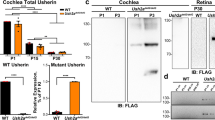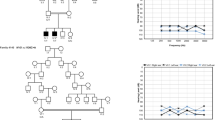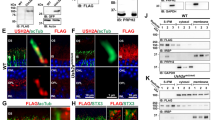Abstract
Usher syndrome type 1 (USH1) is an autosomal recessive sensory defect involving congenital profound sensorineural deafness, vestibular dysfunction and blindness (due to progressive retinitis pigmentosa)1. Six different USH1 loci have been reported. So far, only MYO7A (USH1B), encoding myosin VIIA (ref. 2), has been identified as a gene whose mutation causes the disease. Here, we report a gene underlying USH1C (MIM 276904), a USH1 subtype described in a population of Acadian descendants from Louisiana3 and in a Lebanese family4. We identified this gene (USH1C), encoding a PDZ-domain–containing protein, harmonin, in a subtracted mouse cDNA library derived from inner ear sensory areas. In patients we found a splice-site mutation, a frameshift mutation and the expansion of an intronic variable number of tandem repeat (VNTR). We showed that, in the mouse inner ear, only the sensory hair cells express harmonin. The inner ear Ush1c transcripts predicted several harmonin isoforms, some containing an additional coiled-coil domain and a proline- and serine-rich region. As several of these transcripts were absent from the eye, we propose that USH1C also underlies the DFNB18 form of isolated deafness.
This is a preview of subscription content, access via your institution
Access options
Subscribe to this journal
Receive 12 print issues and online access
$209.00 per year
only $17.42 per issue
Buy this article
- Purchase on Springer Link
- Instant access to full article PDF
Prices may be subject to local taxes which are calculated during checkout





Similar content being viewed by others
References
Kimberling, W.J. & Moller, C. Clinical and molecular genetics of Usher syndrome. J. Am. Acad. Audiol. 6, 63–72 (1995).
Weil, D. et al. Defective myosin VIIA gene responsible for Usher syndrome type 1B. Nature 374, 60–61 (1995).
Smith, R.J. et al. Localization of two genes for Usher syndrome type I to chromosome 11. Genomics 14, 995–1002 (1992).
Saouda, M. et al. The Usher syndrome in the Lebanese population and further refinement of the USH2A candidate region. Hum. Genet. 103, 193–198 (1998).
Erkman, L. et al. Role of transcription factors Brn-3.1 and Brn-3.2 in auditory and visual system development. Nature 381, 603–606 (1996).
El-Amraoui, A. et al. Human Usher 1B/mouse shaker-1: the retinal phenotype discrepancy explained by the presence/absence of myosin VIIA in the photoreceptor cells . Hum. Mol. Genet. 5, 1171– 1178 (1996).
Probst, F.J. et al. Correction of deafness in shaker-2 mice by an unconventional myosin in a BAC transgene. Science 280, 1444–1447 (1998).
Yasunaga, S. et al. A mutation in OTOF, encoding otoferlin, a FER-1-like protein, causes DFNB9, a nonsyndromic form of deafness. Nature Genet. 21, 363–369 (1999).
Kubisch, C. et al. KCNQ4, a novel potassium channel expressed in sensory outer hair cells, is mutated in dominant deafness. Cell 96 , 437–446 (1999).
Cohen-Salmon, M., El-Amraoui, A., Leibovici, M. & Petit, C. Otogelin: a glycoprotein specific to the acellular membranes of the inner ear. Proc. Natl Acad. Sci. USA 94, 14450 –14455 (1997).
Verpy, E., Leibovici, M. & Petit, C. Characterization of otoconin-95, the major protein of murine otoconia, provides insights into the formation of these inner ear biominerals . Proc. Natl Acad. Sci. USA 96, 529– 534 (1999).
Scanlan, M.J. et al. Characterization of human colon cancer antigens recognized by autologous antibodies. Int. J. Cancer 76, 652–658 (1998).
Scanlan, M.J. et al. Isoforms of the human PDZ-73 protein exhibit differential tissue expression. Biochim. Biophys. Acta 1445, 39–52 (1999).
Kobayashi, I. et al. Identification of an autoimmune enteropathy-related 75-kilodalton antigen. Gastroenterology 117, 823– 830 (1999).
Ponting, C.P., Phillips, C., Davies, K.E. & Blake, D.J. PDZ domains: targeting signalling molecules to sub-membranous sites. Bioessays 19, 469–479 ( 1997).
Fanning, A.S. & Anderson, J.M. Protein modules as organizers of membrane structure. Curr. Opin. Cell Biol. 11, 432–439 (1999).
Higgins, M.J. et al. Contig maps and genomic sequencing identify candidate genes in the usher 1C locus. Genome Res. 8, 57 –68 (1998).
DeAngelis, M.M. et al. Assembly of a high-resolution map of the Acadian Usher syndrome region and localization of the nuclear EF-hand acidic gene. Biochim. Biophys. Acta 1407, 84–91 (1998).
Senapathy, P., Shapiro, M.B. & Harris, N.L. Splice junctions, branch point sites, and exons: sequence statistics, identification, and applications to genome project. Methods Enzymol. 183, 252–278 (1990).
Bidichandani, S.I., Ashizawa, T. & Patel, P.I. The GAA triplet-repeat expansion in Friedreich ataxia interferes with transcription and may be associated with an unusual DNA structure . Am. J. Hum. Genet. 62, 111– 121 (1998).
Sudol, M. From Src homology domains to other signaling modules: proposal of the ‘protein recognition code’. Oncogene 17, 1469 –1474 (1998).
Jain, P.K. et al. A gene for recessive nonsyndromic sensorineural deafness (DFNB18) maps to the chromosomal region 11p14–p15.1 containing the Usher syndrome type 1C gene. Genomics 50, 290– 292 (1998).
Simmler, M.-C. et al. Targeted disruption of otogelin results in deafness and severe imbalance. Nature Genet. 24, 139–143 (2000).
Hasson, T. et al. Unconventional myosins in inner-ear sensory epithelia. J. Cell Biol. 137, 1287–1307 (1997).
Sahly, I., El-Amraoui, A., Abitbol, M., Petit, C. & Dufier, J.L. Expression of myosin VIIA during mouse embryogenesis. Anat. Embryol. (Berl) 196, 159–170 (1997).
Wolfrum, U., Liu, X., Schmitt, A., Udovichenko, I.P. & Williams, D.S. Myosin VIIa as a common component of cilia and microvilli . Cell Motil. Cytoskeleton 40, 261– 271 (1998).
Steel, K.P. Inherited hearing defects in mice. Annu. Rev. Genet. 29, 675–701 (1995).
Hubank, M. & Schatz, D.G. Identifying differences in mRNA expression by representational difference analysis of cDNA. Nucleic Acids Res. 22, 5640–5648 (1994).
Legan, P.K., Rau, A., Keen, J.N. & Richardson, G.P. The mouse tectorins. Modular matrix proteins of the inner ear homologous to components of the sperm-egg adhesion system. J. Biol. Chem. 272 , 8791–8801 (1997).
Devereux, J., Haeberli, P. & Smithies, O. A comprehensive set of sequence analysis programs for the VAX. Nucleic Acids Res. 12, 387– 395 (1984).
Bitner-Glindzicz, M. et al. A recessive contiguous gene deletion causing infantile hyperinsulinism, enteropathy and deafness identifies the Usher type 1C gene. Nature Genet. 26, 56–60 ( 2000).
Acknowledgements
We thank J. Loiselet for collaboration; S. Bundey, M. Batzer, M. DeAngelis, P. Deininger, J. Doucet, M. Pelias and S. Savas for clinical and genetic analysis of Usher patients; J.-P. Hardelin and S. Safieddine for critical reading of the manuscript; M. Grati, B. Boeda and M. Cohen-Salmon for providing us with mouse RNA; M. Mustapha and L. Gresh for advice; and S. Chardenoux and O. Ardouin for aid with figure drawing. This work was supported by grants from the European Economic Community (QLG2-CT-1999-00988), Retina France, Fondation pour la Recherche Médicale, König Forschung contra Blindheit Initiative Usher Syndrome, CEDRE funds (968/R), the Foundation Fighting Blindness, the Deafness Research Foundation NIHR01 DC02530, and NIDCD R03 DC04530, and by C. and J.-P. Bernais donation.
Author information
Authors and Affiliations
Corresponding author
Supplementary information
Rights and permissions
About this article
Cite this article
Verpy, E., Leibovici, M., Zwaenepoel, I. et al. A defect in harmonin, a PDZ domain-containing protein expressed in the inner ear sensory hair cells, underlies Usher syndrome type 1C. Nat Genet 26, 51–55 (2000). https://doi.org/10.1038/79171
Received:
Accepted:
Issue Date:
DOI: https://doi.org/10.1038/79171
This article is cited by
-
Human deafness-associated variants alter the dynamics of key molecules in hair cell stereocilia F-actin cores
Human Genetics (2022)
-
The genetic and phenotypic landscapes of Usher syndrome: from disease mechanisms to a new classification
Human Genetics (2022)
-
Usher syndrome type IV: clinically and molecularly confirmed by novel ARSG variants
Human Genetics (2022)
-
Targeting PDZ domains as potential treatment for viral infections, neurodegeneration and cancer
Biology Direct (2021)
-
Rescue of Outer Hair Cells with Antisense Oligonucleotides in Usher Mice Is Dependent on Age of Treatment
Journal of the Association for Research in Otolaryngology (2018)



